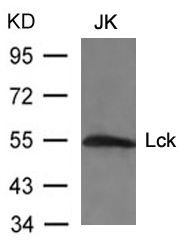Product Detail
Product NameLck(Ab-394) Antibody
Host SpeciesRabbit
ClonalityPolyclonal
PurificationAntibodies were produced by immunizing rabbits with synthetic peptide and KLH conjugates. Antibodies were purified by affinity-chromatography using epitope-specific peptide.
ApplicationsWB
Species ReactivityHu Ms Rt
SpecificityThe antibody detects endogenous levels of total Lck protein.
Immunogen TypePeptide-KLH
Immunogen DescPeptide sequence around aa.392-396(N-E-Y-T-A) derived from Human Lck.
Target NameLck
ConjugateUnconjugated
Other NamesLSK; YT16; p56lck; pp58lck;
Accession NoSwiss-Prot: P06239
NCBI Protein: NP_001036236.1
Uniprot
P06239
Gene ID
3932;
Concentration1.0mg/ml
FormulationSupplied at 1.0mg/mL in phosphate buffered saline (without Mg2+ and Ca2+), pH 7.4, 150mM NaCl, 0.02% sodium azide and 50% glycerol.
StorageStore at -20°C for long term preservation (recommended). Store at 4°C for short term use.
Application Details
Predicted MW: 56kd
Western blotting: 1:500~1:1000
Western blot analysis of extracts from JK cells using Lck(Ab-394) Antibody #21167.
Non-receptor tyrosine-protein kinase that plays an essential role in the selection and maturation of developing T-cells in the thymus and in the function of mature T-cells. Plays a key role in T-cell antigen receptor (TCR)-linked signal transduction pathways. Constitutively associated with the cytoplasmic portions of the CD4 and CD8 surface receptors. Association of the TCR with a peptide antigen-bound MHC complex facilitates the interaction of CD4 and CD8 with MHC class II and class I molecules, respectively, thereby recruiting the associated LCK protein to the vicinity of the TCR/CD3 complex. LCK then phosphorylates tyrosines residues within the immunoreceptor tyrosine-based activation motifs (ITAM) of the cytoplasmic tails of the TCR-gamma chains and CD3 subunits, initiating the TCR/CD3 signaling pathway. Once stimulated, the TCR recruits the tyrosine kinase ZAP70, that becomes phosphorylated and activated by LCK. Following this, a large number of signaling molecules are recruited, ultimately leading to lymphokine production. LCK also contributes to signaling by other receptor molecules. Associates directly with the cytoplasmic tail of CD2, which leads to hyperphosphorylation and activation of LCK. Also plays a role in the IL2 receptor-linked signaling pathway that controls the T-cell proliferative response. Binding of IL2 to its receptor results in increased activity of LCK. Is expressed at all stages of thymocyte development and is required for the regulation of maturation events that are governed by both pre-TCR and mature a beta TCR. Phosphorylates other substrates including RUNX3, the microtubule-associated protein MAPT, RHOH or TYROBP.
Goh Y.M., Cinghu S., Hong E.T., Lee Y.S., Kim J.H., Jang J.W., Li Y.H., Chi X.Z., Lee K.S., Wee H., Ito Y., Oh B.C., Bae S.C.J. Biol. Chem. 285:10122-10129(2010)
Wang H., Zeng X., Fan Z., Lim B.Cell. Signal. 23:249-258(2011)
Scales T.M., Derkinderen P., Leung K.Y., Byers H.L., Ward M.A., Price C., Bird I.N., Perera T., Kellie S., Williamson R., Anderton B.H., Reynolds C.H.Mol. Neurodegener. 6:12-12(2011)
If you have published an article using product 21167, please notify us so that we can cite your literature.



 Yes
Yes



